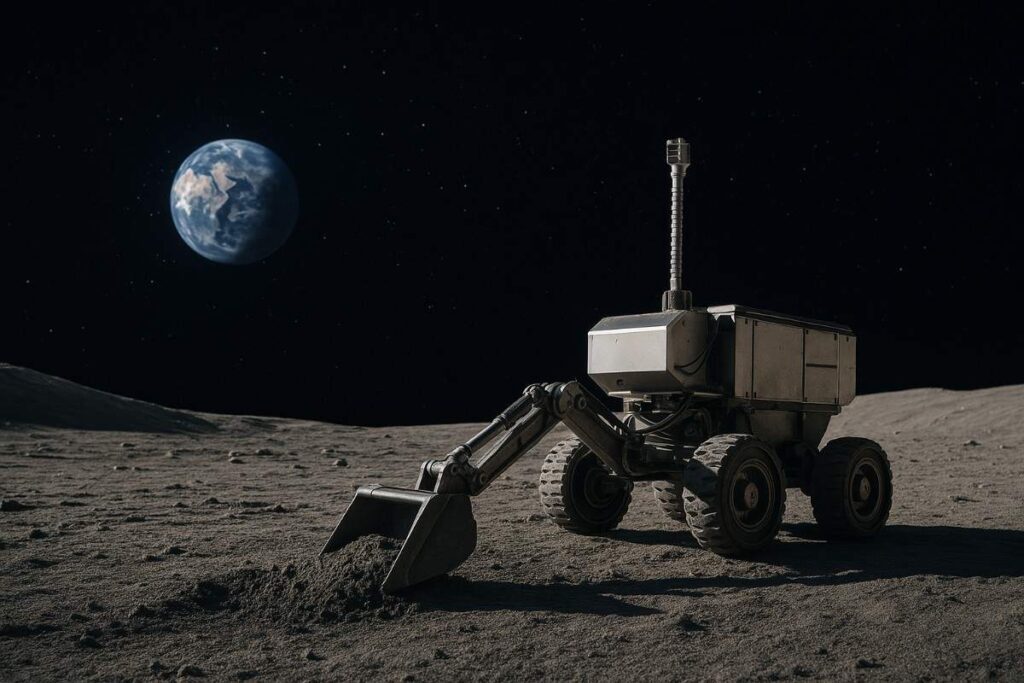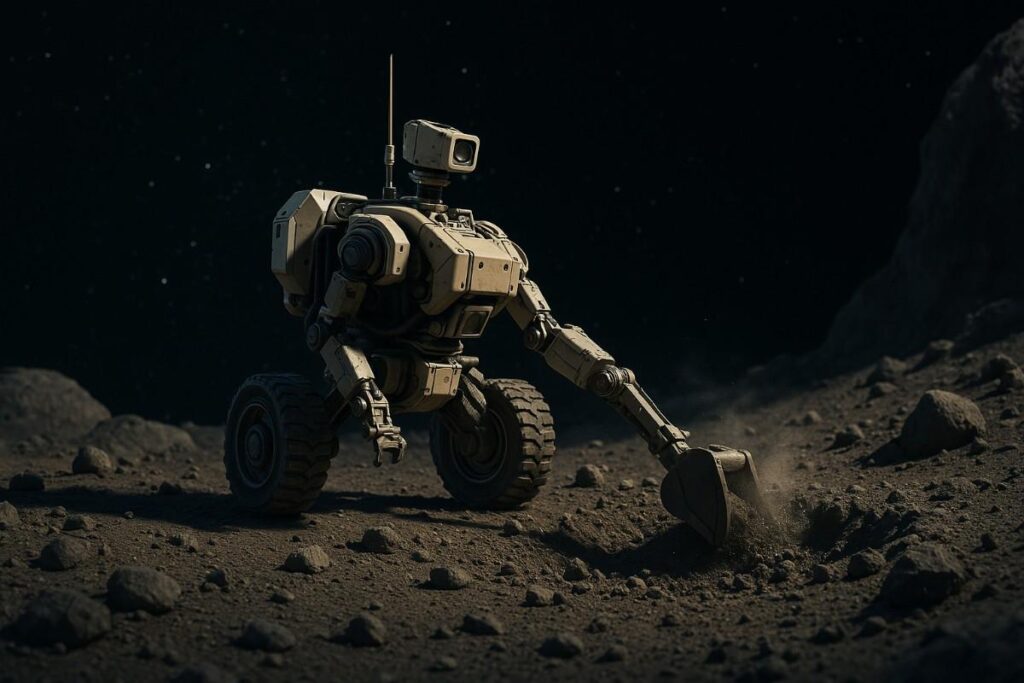Over the past decade, the mining sector on Earth has quietly transformed. Remote-controlled drills, autonomous trucks, and robotic systems now operate in some of the harshest environments – from underground tunnels to the frozen Arctic. These autonomous mining robots already handle complex operations with minimal human intervention, boosting safety, efficiency, and output.
This progress offers a clear preview of what lies ahead beyond Earth. As humanity expands its presence beyond Earth, space mining is becoming less about rare materials for Earth and more about supporting future space industries and settlements. The focus is shifting from science fiction to strategic planning for long-term space sustainability.
And driving that shift? Autonomous robots.
Why Space Needs Machines That Work on Their Own?
Mining celestial bodies like the Moon, Mars, or asteroids presents extreme challenges. The harsh environment, extreme temperatures, space debris, and lack of infrastructure mean that traditional human-led missions won’t cut it. Machines need to do the job. And not just any machines – autonomous systems with advanced technology capable of carrying out tasks independently.
These robotic systems must be equipped with advanced sensors, artificial intelligence, and rugged engineering to operate in outer space, like NASA’s RASSOR excavator robot, designed specifically for mining lunar regolith. They must be able to perform complex mining operations, like extracting and transporting raw materials, all while handling limited communication delays with mission control on Earth.
Earth, Moon, Mars, and Asteroids: Different Places, Different Rules

When talking about space mining, it’s useful to break things down into two main environments:
1. Mining the Moon and Mars
These bodies have some gravity, stable surfaces, and long-term goals tied to human settlements. Mining operations here are expected to focus not only on valuable minerals and metals but also on building materials like regolith (for bricks) and extracting water ice (for life support and fuel), supporting a sustainable presence for human exploration.
These environments allow for more traditional-looking machinery, though with unique engineering for survival in space. For example:
- Gravity makes anchoring easier: Machines can roll or walk across the surface using wheels or legs, providing a familiar mode of locomotion.
- Solar panels work well: These locations receive consistent sunlight, making them ideal for solar-powered robotic systems to operate reliably over long periods.
- Mining goals are practical: Missions are expected to focus on gathering water, regolith, and metals to enable sustainable presence and construction, rather than just transporting resources back to Earth.
- Conditions are still tough: Even with gravity and sunlight, these places come with harsh conditions – extreme temperatures, radiation, and dust storms – making human intervention risky and only occasional.
This means machines must be highly autonomous, rugged, and able to operate 24/7 with only occasional check-ins from Earth.
2. Mining Asteroids
Asteroids are a different beast altogether. Many of them have microgravity or no gravity at all, which means we can’t just roll up a mining robot and expect it to work like on the Moon.
These unique conditions require a fundamentally different approach in both design and operation:
- Anchoring is a challenge: In near-zero gravity, robots must secure themselves to the surface to avoid drifting off. This might involve harpoons, drill-in anchors, or electrostatic adhesion systems.
- Mobility requires innovation: Without gravity to keep them grounded, mining robots need to move carefully. Concepts like small thrusters, magnetic tethers, or screw-propelled systems have been proposed to allow movement across or into an asteroid’s surface.
- Mining must be gentle: Applying too much force could destabilize the asteroid or send valuable resources floating into space. This limits the use of traditional drilling and demands gentler, more controlled extraction techniques.
- Material handling needs care: Collecting even fine dust becomes a precision task. Enclosed chambers, suction devices, or sealed containers must be used to capture and store material without loss.
Despite these challenges, the rewards are massive.
Key Technology for a New Frontier
To make space mining work, we need more than shovels and drills. We need autonomous mining equipment that can make decisions, navigate unpredictable terrain, and function without real-time human input. That’s where technological advancements like AI, edge computing, and swarm robotics play a crucial role.
Let’s break down some of the core tech:
Artificial intelligence (AI): AI allows autonomous mining robots to analyze unfamiliar terrain, identify hazards, optimize drilling paths, and make rapid decisions in unpredictable situations. This becomes essential in space environments where real-time human guidance is limited or delayed.
Advanced sensors: A combination of LIDAR, thermal imaging, spectrometers, and force sensors enables machines to scan surfaces, detect mineral compositions, and monitor structural integrity during operations. These sensors are crucial for operating in darkness or through dust and radiation.
Edge computing: With edge computing, robots process data locally, enabling instant reactions to sensor input. For instance, a robot mining an asteroid can adjust its grip or halt operations if it detects instability, without needing to wait for Earth-based commands.
Autonomous systems: These include everything from self-driving mobility platforms to automated excavation and material sorting. Their ability to adapt, recalibrate, and recover from small system failures without external input is key to long-duration missions.
Sustainable power sources: Solar panels remain the most practical energy source in space, particularly near the Moon or inner asteroids. They’re light, durable, and can power a wide range of robotic systems continuously, so long as sunlight is available.
Together, these make up the backbone of autonomous mining robots capable of performing under harsh conditions.
Legal, Ethical, and Practical Challenges
Of course, it’s not just about sending machines out and digging in. There are serious challenges still to solve:
Legal frameworks: Who owns space resources? What counts as fair use? These questions are still being debated in the international space law community. Without clear ownership rules, disputes between nations or private companies could create serious legal and diplomatic issues.
Environmental impact: Even in space, mining needs regulation. Extracting resources without careful planning could damage celestial bodies or interfere with scientific research. Setting boundaries will be essential to prevent long-term harm.
Space debris: The growing cloud of debris in Earth orbit is already a problem. Introducing mining operations increases the risk of collisions and adds to the clutter unless properly managed with strict protocols.
Safety concerns: Malfunctioning machines or failed landings could pose real risks, not just to future missions, but also to human life if settlements are nearby. Ensuring operational reliability is critical.
Cost and complexity: Developing, launching, and operating autonomous mining robots in space is extremely expensive. Systems must be robust enough to work for long periods without repair, making reliability and return on investment key concerns.
Many experts, including engineers, ethicists, and even the occasional associate professor, are working on these issues to make space mining sustainable and secure.
What’s Happening Now? The Players in the Game
While this blog focuses more on the overall concept, it’s worth noting that several companies and agencies are actively working to make space mining real:
Planetary Resources: Founded in the early 2010s, Planetary Resources was one of the first private companies to announce plans to mine asteroids for water and precious metals. Though it eventually paused operations and was acquired in 2018, the startup played a foundational role in drawing investor and public attention to the commercial potential of space mining.
AstroForge: A newer player aiming to revive asteroid mining efforts, AstroForge launched its first in-orbit refining experiment, Odin. Despite facing setbacks like communication delays and hardware issues, the company has continued with plans for a second mission to scout a metal-rich asteroid using a robotic spacecraft. Its main focus is on refining and retrieving precious metals like platinum in microgravity.
Karman+: Based in the U.S. and backed by recent venture funding, Karman+ is building an autonomous mining spacecraft designed to extract water from asteroids. Their concept centers around using this water as in-orbit fuel for satellites, effectively creating a space-based refueling station. This approach, if successful, could reduce launch costs and support long-term infrastructure in space.
NASA & ESA: Both agencies are heavily involved in space resource utilization research. NASA has launched the Artemis program, which includes plans to extract water from lunar ice to support human missions. ESA is also funding studies into how lunar regolith can be processed into oxygen or used as building material. These initiatives aim to create a sustainable presence on the Moon rather than bringing materials back to Earth.
Private contractors: Companies like Astrobotic and ispace are collaborating with government agencies to develop autonomous mining equipment and delivery systems. These include lunar rovers, landers, and tools capable of prospecting for resources such as ice or metals on the Moon and potentially on Mars in the future. Many of these projects are part of broader public-private partnerships to test key technologies for space mining.
Each of these players has a slightly different approach, but they all rely on the same core principle: let the robots do the hard work.
Designing for Space Mining Operations

Here are a few principles that engineers are applying to design the next generation of mining robots:
- Minimal human intervention: Machines must handle tasks independently with limited oversight.
- Adaptability: Systems must work across a wide range of terrains and conditions.
- Durability: Machines must survive radiation, vacuum, and extreme temperatures.
- Scalability: Swarm robots can work together, covering more ground and increasing efficiency.
- Reusability: Robots should be fixable, upgradeable, or even reusable across missions.
These principles are already guiding prototypes and simulations in labs around the world.
The Future of Mining, on Earth and in Space
The line between science fiction and practical engineering continues to blur. Autonomous mining robots are already reshaping how we think about exploration – both on Earth and beyond it. As these systems grow more advanced, they open up new possibilities for extracting useful materials from celestial bodies without constant human oversight.
Space mining is just one piece of a much larger picture – a gradual shift toward a lasting human presence beyond Earth.